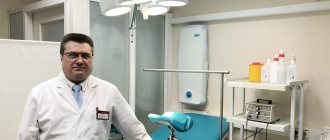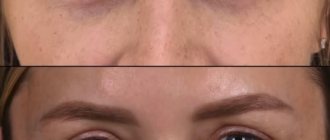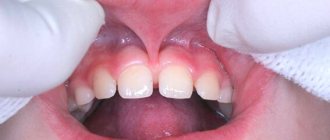Circumcision or circumcision is an operation that is performed for religious, medical, hygienic and even psychological reasons. Usually infants and young boys are subjected to it, but sometimes circumcision is also performed on adult men. Before you decide to have the operation, you should find out all the details about it, as well as take care of proper post-operative care. From this article you will learn how to do circumcision correctly, under anesthesia or not, photos of circumcision are also presented here in sufficient quantities.
Partial circumcision of the foreskin - what is it?
Partial male circumcision, more accurately called “incomplete circumcision,” is a surgical procedure in which only part of the foreskin (prepuce) of the penis is removed, leaving the head of the penis partially covered.
If complete circumcision is performed primarily in accordance with the cultural and religious traditions of a man and is much less often performed for medical reasons, then incomplete circumcision is a purely medical procedure, that is, not in any way related to culture or religion.
What conclusions are drawn based on scientific assessments?
Based on the results of many studies, the following has been established.
In circumcised men, penile cancer develops much less often, several times, compared to those who have a natural foreskin.
Similar statistics are available for women, if the sexual partner is circumcised - cervical cancer is up to seven times less common in them.
Genital infections also develop less frequently in those who have undergone circumcision.
According to sex therapists, a circumcised penis looks more aesthetically pleasing and attractive - a neat head of the penis is perceived better than unaesthetic and wrinkled skin.
More hygienic, without a doubt, is an open head, because the possibility of accumulation of natural secretions and dirt is reduced to almost zero. This area no longer creates an environment conducive to the proliferation of any pathogenic microflora. As a result, the risk of developing inflammatory diseases - local and generalized inflammation and erosions - is greatly reduced.
A circumcised head leaves no chance of getting phimosis and balanoposthitis.
Matar Asaad Akhmadovich
Head of the center, professor, pediatric surgeon, urologist-andrologist
The main principle of our center is high professionalism, dedication to their profession, human participation and mutual understanding between specialists, young patients and their parents!
Go to doctor's page
Indications for circumcision
A common indication for partial circumcision is phimosis. This is the narrowness of the foreskin, making it difficult to freely expose the head of the penis. In this case, if the phimosis is localized on the upper or middle part of the foreskin, the doctor can excise only that area of the prepuce that directly prevents the free exposure of the head of the penis.
Other indications for incomplete circumcision include:
- hypertrophic (proboscis) phimosis - excessive growth of the foreskin, when exposure of the head of the penis does not occur even with a full erection;
- polyps or condylomas on the foreskin;
- chronic balanoposthitis - inflammation of the inner part of the prepuce;
- trauma - if it is impossible to restore the foreskin.
Progress of the operation
There are two main methods of circumcision:
- Dorsal incision (from the back of the penis).
- Removing flesh using a clamp.
A dorsal incision is performed for phimosis and paraphimosis. After cutting the adhesions, clamps are applied to the foreskin (conditional positions 1 and 11 o'clock), the skin is cut off along the marked circular line, and sutures are applied. All manipulations are accompanied by coagulation of blood vessels. A sterile bandage is applied to the wound.
Healthy men who do not have phimosis undergo circumcision with clamping. As for laser circumcision, it is not popular due to the high risk of burns. The radio wave method has many more advantages. The healing rate is two times higher than after using a metal scalpel.
Types of partial circumcision
Based on the nature of the procedure, the incomplete circumcision procedure can be divided into two types:
- high circumcision.
A small part of the foreskin is removed, as a result of which the head of the penis is exposed to a maximum of the middle;
- low cut.
The foreskin is removed along the coronal groove of the penis.
The issue of preserving or removing the frenulum during partial circumcision is decided individually based on the reasons for which the operation is performed.
Preparation for the procedure
Circumcision of the foreskin in adults is performed on an outpatient basis or in a hospital.
- For adolescents, general anesthesia is used; adult men are more often given local anesthesia. Circumcision is impossible without anesthesia.
- Before the procedure, you must take a blood test to confirm the absence of infections and inflammation.
- If you have sexually transmitted diseases, you need to completely cure them and only then think about circumcision.
Before the operation, the penis is disinfected with special preparations and clamped with a tourniquet at the base. Anesthetics (lidocaine, ultracaine, killezin) are injected into the penis tissue with a thin needle.
How is circumcision performed correctly?
Partial circumcision is performed under local or general anesthesia using a surgical scalpel or laser. The operation itself is performed as follows:
- the foreskin is fixed and stretched. Sometimes, for the convenience of the surgeon, the penis is put into a state of artificial erection;
- the prepuce is excised in a circle to the required extent;
- sutures made of self-absorbing materials are placed at the incision site, and an antiseptic bandage is placed over the sutures.
In general, the incomplete circumcision operation lasts no longer than half an hour. Full hospitalization after partial circumcision is not required; after 2-4 hours the patient can freely leave the medical center.
When do doctors recommend circumcision?
Excision of the foreskin is recommended if the patient has the following problems.
Phimosis is difficulty opening the head due to narrowing of the foreskin. For boys under three years of age, this condition is physiological; in the future, the problem may disappear on its own. Cicatricial phimosis – when the head can be opened only after surgery.
The diagnosis of cicatricial phimosis is made when a ball forms at the end of the penis. When urinating, the stream of urine is thin.
Phimosis is dangerous due to the risk of developing paraphimosis, when swelling of the penis occurs due to compression of the head. Gradually, tissue death occurs, and another operation is required - amputation of the penis.
Phimosis does not allow for good hygiene; lubricant accumulates in the folds, causing negative consequences.
Circumcision is also recommended in case of various neoplasms, genital warts and warts that appear on the frenulum, which can develop into malignant ones.
Balanitis and recurrent balanoposthitis are inflammation of the head of the penis and foreskin. The disease occurs due to neglect of hygiene rules and is accompanied by swelling, redness of the penis, painful urination, and discharge with pus. Surgery is recommended only if the disease enters the chronic phase and there is a danger of relapses and the formation of phimosis.
Multiple condylomas resemble viral papillomas and warts and are located on the foreskin or on the head of the penis. These growths are considered a precancerous condition, so the foreskin must be excised.
| aesthetic defect after circumcision | corrected aesthetic defect |
Features of rehabilitation after partial circumcision
Complete healing of the circumcised foreskin occurs within 1-4 weeks, depending on the general physical condition of the patient and the method of surgery. During this period, the patient is prohibited from:
- have sexual intercourse or masturbate;
- engage in active sports;
- visit the pool, bathhouse or sauna.
To relieve postoperative pain, patients are prescribed a general pain reliever - analgin, ketanov, etc. Dressings and scar care are performed using those antiseptic and/or antibacterial agents prescribed by the attending physician. It is also recommended to gently wash the penis with warm water after each urination.
Arguments in favor of circumcision
- In countries where almost all men are circumcised, HIV infections occur in only 6% of the population. Conversely, in countries where the circumcision procedure is performed on a small number of residents (from 10 to 30%), this percentage is much higher - HIV carriers make up almost 1/4 of the population.
- Among men infected with AIDS, the overwhelming majority are uncircumcised. Doctors attribute this fact to the fact that microtraumas of the foreskin create a favorable environment for infection by the AIDS virus.
- Among men with hepatitis, the majority are also uncircumcised. The explanation for this fact also lies in the frequent occurrence of microtraumas of the foreskin, and the hepatitis virus affects precisely these areas.
- If the foreskin is excised, there is nowhere for the lubricant of the penis to accumulate - there are no conditions for the development of infection. Therefore, not only the risk of inflammatory diseases is reduced, but also sexually transmitted infections.
Possible complications
Complications that may occur after circumcision of the foreskin include:
- bleeding. During the first 2-3 days, slight bleeding is normal. To stop the bleeding, you need to press the bleeding area with a sterile cloth or bandage for 5-10 minutes;
- suppuration. Occurs when there is insufficient quality care for the postoperative scar and requires the intervention of a urological surgeon;
- swelling. Can last up to 2-3 weeks. An alarming sign is increased swelling with the addition of severe pain;
- peeling of the head of the penis. A variation of the normal reaction of the scalp to the removal of protection in the form of the prepuce. The crusts that appear during the peeling process can be soaked with chlorhexidine;
- lumps under the foreskin. Usually we are talking about thrombosed vessels that spontaneously resolve within a month;
- difficulty urinating. Often caused by a psychological fear of urinating immediately after surgery, which disappears within 1-2 days, but in the presence of pain it can be a sign of an inflammatory process.
If the listed complications do not disappear over the specified period of time, the patient should see his doctor.
Post-operative care: secrets of quick recovery
In the first hours after the circumcision operation and the weakening of the anesthesia, the patient may feel pain, which is relieved with the help of anesthetics; the discomfort completely disappears after 1-2 days.
- Postoperative sutures are processed daily. In the first 3 days, the sterile dressing is changed 3 times a day.
- Then the procedure can be performed once a day. The bandage is soaked in hydrogen peroxide or a decoction of chamomile, this allows you to remove it without pain and without injuring the wound.
- The dressings are changed for 10 days, then the suture area remains open. To disinfect, it is treated with hydrogen peroxide or chlorhexidine. There is no need to remove sutures; the threads dissolve on their own.
In some cases, patients experience bloody discharge. Treating the seams with Levomekol, a solution of furatsilin or potassium permanganate will help remove them. Taking Methyluracil will help speed up the healing of wounds. If bleeding does not stop, urgent consultation with a urologist is necessary. It is important to monitor your drinking regime. You should not drink too much liquid; instead of diuretic drinks such as coffee and black tea, herbal infusions, homemade fruit drinks and pure still water are recommended.
The recovery period lasts about 2 weeks. During this time, the sutures heal completely, swelling subsides, and the penis takes on a normal appearance. You must abstain from sexual intercourse and masturbation for another 2 weeks.
In the next few months, it is better to use barrier contraceptives (condoms), which reduce the risk of infection or microtrauma. When swelling occurs, baths with table salt are recommended (1 teaspoon per glass of warm water). Circumcision in adult men is an operation that is performed for medical, hygienic and other reasons. There will be no complications, and the recovery period will not be prolonged and the patient will quickly return to normal life, subject to hygiene rules. Thanks to the article, you learned how circumcision is performed, with the patient being admitted to a hospital or on an outpatient basis, and you got acquainted with the photo after the circumcision operation. We hope this information was useful to you!
What is surgery for phimosis?
It is also the most frequently performed by urologists, one might say, “student” operation (like, for example, appendectomy for a general surgeon). And at the same time, it is for this operation that the experience and skill of a urologist in order to “cut off” exactly as much as needed and apply beautiful and reliable sutures.
At the request of the patient, I perform various types of circumcision :
- economical excision of the foreskin, in which only a narrow part of the preputial ring is removed, making it difficult to open the head. As a result, phimosis is eliminated, but the head remains covered with skin
- full (or tight) circumcision, when the foreskin is completely excised and the glans is left open
- plastic surgery of the foreskin, in which the skin is not removed, but is cut and stitched using a special technique, which eliminates phimosis. This option is suitable for men who want the glans to remain covered after surgery, but who do not have enough foreskin skin to perform the first option.
Contraindications
- Hidden penis;
- Micropenis;
- Prematurity;
- Pseudohermaphroditism;
- Epispadias;
- Hypospadias;
- Anomalies in the development of the penis;
- Congenital coagulopathy;
- Hemophilia.
Author: Mamedov Rusif Bezhanovich Plastic surgeon, Candidate of Medical Sciences Received the “Grace” Award in the nomination “Best Plastic Surgeon for Facial Plastic Surgery”. Practices a unique endoscopic lifting technique, which is performed in the upper and middle zone of the face, as well as in its lower part.






